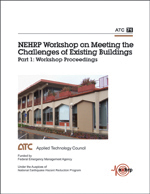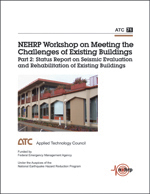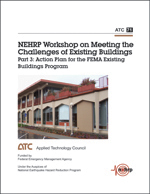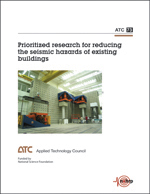ATC-71
PROJECT OVERVIEW
Title: Update Seismic Rehabilitation Guidance Program Definition and Guidance Development
Client: Federal Emergency Management Agency (FEMA)
Status: Completed June 2009
Final Products: Available through the ATC and for download below.
NEHRP Workshop on Meeting the Challenges of Existing Buildings:
Part 1: Workshop Proceedings (published 2008)
Part 2: Status Report on Seismic Evaluation and Rehabilitation of Existing Buildings (published 2009)
Part 3: Action Plan for the FEMA Existing Buildings Program (completed)
Related Projects and Reports: The next phase of work is underway under the ATC-71-1 Project. In addition, the ATC-73 Project has developed the NEHRP Workshop on Meeting the Challenges of Existing Buildings, Prioritized Research for Reducing the Seismic Hazards of Existing Buildings 2008.
PROJECT SUMMARY
While significant progress has been made with respect to development and implementation of standards and guidelines for the seismic rehabilitation of existing buildings in the past two decades, the complex technical, practical, regulatory, and public policy issues surrounding the seismic rehabilitation of existing buildings are far from resolved. The purpose of the ATC-71 project is to develop and produce a comprehensive seismic rehabilitation guidance package for the Federal Emergency Management Agency (FEMA) including necessary implementation strategies for the creation, update, and maintenance of seismic evaluation and rehabilitation documents for existing buildings.
The NEHRP Workshop on Meeting the Challenges of Existing Buildings took place on 19-20 September, 2007, in San Francisco, California. The workshop was co-organized by ATC and the Earthquake Engineering Research Institute, and funded by all four agencies of the National Earthquake hazards reduction Program (NEHRP): FEMA, the National institute of Standards and Technology (NIST), the National Science Foundation (NSF), and the U.S. Geological Survey (USGS). The two-day workshop included active participation of over 90 individuals representing the viewpoints of engineering practitioners, researchers, regulators, building owners, and public policy experts. The ATC-71 Project has produced a series of reports based on the findings at this workshop. Two of the documents can be downloaded using the links below.
The first report in the ATC-71 series is the NEHRP Workshop on Meeting the Challenges of Existing Buildings, Part 1: Workshop Proceedings, summarizing the findings and conclusions from the workshop. In addition, the report also details workshop planning efforts, workshop plenary presentations and discussions, and results of detailed discussions on existing building issues in the Technical, Practical, Regulatory and Public Policy, and Research Needs breakout tracks. You may download a pdf of this document here, or go to our online store to purchase a copy for your library.
The second report in the series, NEHRP Workshop on Meeting the Challenges of Existing Buildings, Part 2: Status Report on Seismic Evaluation and Rehabilitation of Existing Buildings, reflects a current understanding of the many factors affecting seismic evaluation and rehabilitation in the United States. The report provides a brief description of FEMA’s Existing buildings Program and the FEMA 315 Report, Seismic Rehabilitation of Buildings: Strategic Plan 2005 and discusses seismic evaluation and rehabilitation from different perspectives. You may download a pdf of this document here, or go to our online store to purchase a copy for your library.
The third report, NEHRP Workshop on Meeting the Challenges of Existing Buildings, Part 3: Action Plan for the FEMA Existing Buildings Program, develops a prioritized list of tasks for the Existing Buildings Program including those uncompleted tasks from previous action plans that best serve the goal of increasing the number of seismically “at risk” buildings being identified and their risk being reduced to an acceptable level by rehabilitation. The prioritization identifies Near Term, Mid Term and Long Term activities. It also develops recommendations for promoting and updating the ASCE 31 and ASCE 41 standards in ways that reflect new research and technical developments thus facilitating their broader application. The plan is anticipated to encompass a 10-year time span. You may download a pdf of this document here, or go to our online store to purchase a copy for your library.
An additional report, NEHRP Workshop on Meeting the Challenges of Existing Buildings, Prioritized Research for Reducing the Seismic Hazards of Existing Buildings, prepared for the National Science Foundation under the ATC-73 Project, is also available. This report is written to help establish earthquake engineering research priorities for the George E. Brown, Jr. Network for Earthquake Engineering Simulation (NEES). You can download an initial copy of the document created for download, here.
The next phase of work is underway and is called the ATC-71-1 Project, Development of Simplified Guidance for Seismic Rehabilitation of Soft-Story Wood-Frame Buildings. Under this project, guidance will be developed to address seismic retrofit requirements for soft-story wood-frame buildings in seismically active regions of the United States, focusing primarily on Northern and Southern California and the Pacific Northwest. Configurations to be addressed will include multi-family-unit, multi-story soft-story buildings, such as those prevalent in San Francisco, and apartment buildings with tuck-under parking, such as those significantly damaged by the 1994 Northridge earthquake in Southern California. The project will also develop practical model code provisions for seismic retrofit of soft-story wood-frame buildings that can be adopted by cities such as San Francisco and that are written to ensure that application and enforcement are uniform and enforceable.
